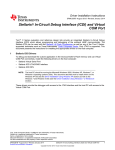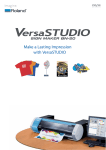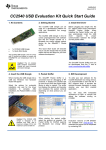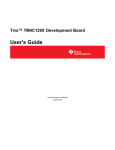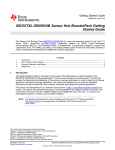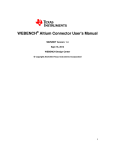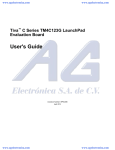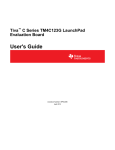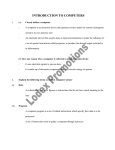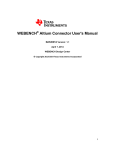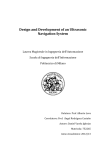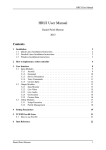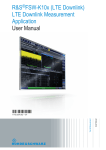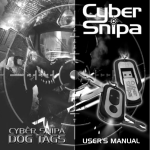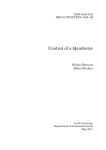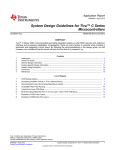Download BOOSTXL-IOBKOUT GPIO Breakout BoosterPack
Transcript
GPIO Breakout BoosterPack User's Guide Literature Number: SPMU364 January 2014 Contents 1 Board Overview 1.1 1.2 1.3 2 .................................................................................................................. 4 Kit Contents .................................................................................................................. 5 Features ...................................................................................................................... 5 Specifications ................................................................................................................ 5 Hardware Description 2.1 2.2 2.3 2.4 2.5 2.6 2.7 .......................................................................................................... 6 BoosterPack XL Connector ................................................................................................ 7 Tiva™ C Series LaunchPad Compatibility ............................................................................... 7 Standard BoosterPack Pinout Compatibility ............................................................................. 8 EK-TM4C123GXL LaunchPad Shared Signals ......................................................................... 9 Screw Terminals and Header Positions ................................................................................ 10 Analog Signals ............................................................................................................. 11 ESD Protection ............................................................................................................ 11 D ........................................................................................................................... ................................................................................. Bill of Materials ................................................................................................................. Board Drawing .................................................................................................................. References ....................................................................................................................... Schematics ....................................................................................................................... 2 Contents 3 A B C Software 12 3.1 12 Dual HID Gamepad Demo Application 14 15 16 17 SPMU364 – January 2014 Submit Documentation Feedback Copyright © 2014, Texas Instruments Incorporated www.ti.com List of Figures 1-1. BOOSTXL-IOBKOUT BoosterPack....................................................................................... 4 2-1. BOOSTXL-IOBKOUT BoosterPack Block Diagram .................................................................... 6 2-2. Screw Terminal, Headers, and User Switch Arrangements ......................................................... 10 3-1. Gamepad Axis Mapping .................................................................................................. 13 B-1. Board Drawing ............................................................................................................. 15 List of Tables 1-1. Specifications ................................................................................................................ 5 2-1. BoosterPack XL Interface Connections .................................................................................. 7 2-2. ................................................................................................ Standard BoosterPack Pinout Compatibility ............................................................................. Shared Tiva LaunchPad Signals .......................................................................................... BoosterPack and Gamepad Pin Mapping .............................................................................. Bill of Materials ............................................................................................................ 7 2-3. 2-4. 3-1. A-1. Tiva Port and Pin Mapping SPMU364 – January 2014 Submit Documentation Feedback List of Figures Copyright © 2014, Texas Instruments Incorporated 8 9 12 14 3 Chapter 1 SPMU364 – January 2014 Board Overview The GPIO Breakout BoosterPack (BOOSTXL-IOBKOUT) is a low-cost IO breakout board for Tiva™ C Series LaunchPad BoosterPack XL pinout. Every available signal is connected to a 0.1” header position in addition to the majority being connected to 3.5 mm screw terminals for easy access when prototyping. Figure 1-1 shows the BOOSTXL-IOBKOUT. Figure 1-1. BOOSTXL-IOBKOUT BoosterPack Tiva is a trademark of Texas Instruments. 4 Board Overview SPMU364 – January 2014 Submit Documentation Feedback Copyright © 2014, Texas Instruments Incorporated Kit Contents www.ti.com 1.1 Kit Contents The BOOSTXL-IOBKOUT comes with the following: • GPIO Breakout BoosterPack 1.2 Features The BOOSTXL-IOBKOUT BoosterPack includes the following features: • 3.5 mm screw terminal for all unused I/O – 8 analog – 22 digital – 2 3.3-V terminals – 4 ground terminals • Analog channels equipped with unity-gain amplifiers • ESD protection on every I/O signal and power rail • 3-position user DIP switch • Plated through-holes on a 0.1" grid for each I/O signal • Six 0.125"-diameter mounting holes • Dual HID gamepad demo 1.3 Specifications Table 1-1 shows the specifications for the BOOSTXL-IOBKOUT BoosterPack. Table 1-1. Specifications Parameter Value Board supply voltage 3.3V (via LaunchPad headers) Analog input voltage range 0V to +3.3V Digital input maximum voltage LaunchPad dependent (absolute maximum +5.0V) Digital input minimum voltage 0V Dimensions 3.0" x 4.0" x 0.5" (without LaunchPad) RoHS status Compliant SPMU364 – January 2014 Submit Documentation Feedback Board Overview Copyright © 2014, Texas Instruments Incorporated 5 Chapter 2 SPMU364 – January 2014 Hardware Description The BOOSTXL-IOBKOUT BoosterPack provides many useful features that aid in prototyping a variety of projects with Tiva™ C Series LaunchPads (see Figure 2-1). This chapter describes the BOOSTXLIOBKOUT hardware features. ADC ADC GPIO I2C UART SPI TivaTM C Series LaunchPad 4 4 ESD Protection 11 11 3 I2C UART ESD Protection Headers Headers Op-Amp Unity Gain SPI Screw Terminals Op-Amp Unity Gain ESD Protection Screw Terminals LaunchPad XL Connectors DIP Switch Breakout BoosterPack Figure 2-1. BOOSTXL-IOBKOUT BoosterPack Block Diagram 6 Hardware Description SPMU364 – January 2014 Submit Documentation Feedback Copyright © 2014, Texas Instruments Incorporated BoosterPack XL Connector www.ti.com 2.1 BoosterPack XL Connector The BoosterPack XL connector attaches the BoosterPack to the Tiva™ C Series LaunchPad. Table 2-1 describes how the BoosterPack XL connector maps to the broken-out signals on the BOOSTXLIOBKOUT. Table 2-1. BoosterPack XL Interface Connections 2.2 Pin Function Pin Function Pin Function Pin Function J1.1 +3.3V J3.1 +VBUS J4.1 S2 J2.1 GND J1.2 BR J3.2 GND J4.2 S3 J2.2 A7 J1.3 A8 J3.3 BY J4.3 A6 J2.3 A2 J1.4 A9 J3.4 BX J4.4 B2 J2.4 B1 J1.5 A4 J3.5 AR J4.5 B3 J2.5 NC J1.6 BZ J3.6 AZ J4.6 B4 J2.6 NC J1.7 A5 J3.7 AY J4.7 B5 J2.7 NC J1.8 B8 J3.8 AX J4.8 B6 J2.8 B9 J1.9 A10 J3.9 A3 J4.9 B7 J2.9 B10 J1.10 A11 J3.10 S1 J4.10 A1 J2.10 B11 Tiva™ C Series LaunchPad Compatibility Every available pin on the Tiva™ C Series LaunchPad is brought out to screw terminals or header positions. In the majority of cases, the pins are brought out to both. Table 2-2 describes the Tiva C Series ports and pins that map to the signals on the BOOSTXL-IOBKOUT. Analog signals and the suggested locations for I2C, SSI, and UART are also labeled. Table 2-2. Tiva Port and Pin Mapping A-Side Signals (1) Port/Function B-Side Signals Port/Functions User Switches Port/Functions A1 PF4 B1 PF0 S1 PF1 A2 PE0 B2 PC4 S2 PF2 A3 PE3 B3 PC5 S3 PF3 A4 PE4 B4 PC6 A5 PB4 B5 PC7 A6 PB3 B6 PD6 A7 PB2 B7 PD7 A8 PB0/U1RX B8 PA5/SSI0TX (1) A9 PB1/U1TX B9 PA4/SSI0RX (1) AR PD2/AIN5 BR PB5/AIN11 AX PE2/AIN1 BX PD1/AIN6 AY PE1/AIN2 BY PD0/AIN7 AZ PD3/AIN4 BZ PE5/AIN8 A10 PA6/I2C1SCL B10 PA3/SSI0FSS1 (1) A11 PA7/I2C1SDA B11 PA2/SSI0CLK (1) SSI signals in these positions do not match the standard BoosterPack pinout for SSI. Please see Section 2.3, Standard BoosterPack Pinout Compatibility SPMU364 – January 2014 Submit Documentation Feedback Hardware Description Copyright © 2014, Texas Instruments Incorporated 7 Standard BoosterPack Pinout Compatibility 2.3 www.ti.com Standard BoosterPack Pinout Compatibility The Breakout BoosterPack has the ability to be connected to other LaunchPads that follow the standard LaunchPad pinout. Please refer to Table 2-3 and the BOOSTXLK-IOBKOUT Schematic (Appendix D) when considering using a non-Tiva™ C Series LaunchPad. Table 2-3. Standard BoosterPack Pinout Compatibility Pin Breakout Use Standard Pin Breakout Use Standard J1.1 +3.3V +3.3V J2.1 GND GND J1.2 BR-ANALOG Analog In J2.2 A7 GPIO J1.3 A8-RX UART-RX J2.3 A2 GPIO J1.4 A9-TX UART-TX J2.4 B1 GPIO J1.5 A4 GPIO J2.5 NC Reset J1.6 BZ-ANALOG Analog In J2.6 NC SPI-MOSI J1.7 A5 SPI-CLK J2.7 NC SPI-MISO J1.8 B8-MOSI GPIO J2.8 B9-MISO GPIO J1.9 A10-SCL I2C-SCL J2.9 B10-CS SPI-CS J1.10 A11-SDA I2C-SDA J2.10 B11-SCLK GPIO Pin Breakout Use Standard Pin Breakout Use Standard J3.1 +VBUS +VBUS J4.1 S2 GPIO J3.2 GND GND J4.2 S3 GPIO J3.3 BY-ANALOG Analog In J4.3 A6 GPIO J3.4 BX-ANALOG Analog In J4.4 B2 GPIO J3.5 AR-ANALOG Analog In J4.5 B3 GPIO J3.6 AZ-ANALOG Analog In J4.6 B4 GPIO J3.7 AY-ANALOG Analog In J4.7 B5 GPIO J3.8 AX-ANALOG Analog In J4.8 B6 GPIO J3.9 A3 Reserved J4.9 B7 GPIO J3.10 S1 Reserved J4.10 A1 GPIO Because the BOOSTXL-IOBKOUT is almost entirely a pin-for-pin breakout, the differences between the standard BoosterPack pinout and the Breakout signals are mostly labeling. However, each analog input is connected through a unity-gain amplifier and not directly to the terminals (please see Section 2.6, Analog Signals). Always refer to the BoosterPack Schematic (Appendix D) when connecting hardware. 8 Hardware Description SPMU364 – January 2014 Submit Documentation Feedback Copyright © 2014, Texas Instruments Incorporated EK-TM4C123GXL LaunchPad Shared Signals www.ti.com 2.4 EK-TM4C123GXL LaunchPad Shared Signals The BOOSTXL-IOBKOUT breaks out every available signal on the Tiva™ C Series TM4C123G LaunchPad. Therefore, some of these signals are shared with on-board features of the LaunchPad. Table 2-4 describes which signals are shared with features on the LaunchPad. Table 2-4. Shared Tiva LaunchPad Signals Pin Port/Function LaunchPad Feature BoosterPack Function J2.4 PF0 User Switch 2 B1 J2.5 Reset Reset NC J2.6 PB7 Tied to J3.4 (PD1) NC J2.7 PB6 Tied to J3.3 (PD0) NC J3.3 PD0/AIN7 Tied to J2.7 (PB6) BY J3.4 PD1/AIN6 Tied to J2.6 (PB7) BX J3.10 PF1 LED Red S1 J4.1 PF2 LED Blue S2 J4.2 PF3 LED Green S3 J4.10 PF4 User Switch 1 A1 Please see the BoosterPack Schematic (Appendix D) and the EK-TM3C123GXL User’s Guide (SPMU296) for more information. SPMU364 – January 2014 Submit Documentation Feedback Hardware Description Copyright © 2014, Texas Instruments Incorporated 9 Screw Terminals and Header Positions 2.5 www.ti.com Screw Terminals and Header Positions The available LaunchPad signals are brought out to three main sections on the GPIO Breakout BoosterPack: A-Side, B-Side, and User Switches. A-Side and B-Side signals are all broken out to 3.5 mm-screw terminals with +3.3 V and Ground terminals interspersed throughout. The three remaining signals are brought out to the User Switches in a 3-switch DIP switch. Figure 2-2 shows the screw terminal and switch arrangement. Figure 2-2. Screw Terminal, Headers, and User Switch Arrangements Additionally, every signal is brought out to a 0.1” header position. These can be populated by standard 0.1” breakaway pin headers. All A-Side and B-Side header positions have +3.3V and Ground headers directly adjacent in a Signal-Power-Ground arrangement as shown in Figure 2-2. This arrangement is the same as a standard servo-style connection used in many hobbyist applications. 10 Hardware Description SPMU364 – January 2014 Submit Documentation Feedback Copyright © 2014, Texas Instruments Incorporated Analog Signals www.ti.com 2.6 Analog Signals Each of the eight analog inputs is first passed through a Texas Instruments TLV2374 Rail-to-Rail Operational Amplifier (op amp). The op amps are connected as unity-gain amplifiers in order to provide a low-impedance source to the LaunchPad MCU’s Analog to Digital Converter (ADC). The TLV2374 is a Rail-to-Rail Input/Output Op Amp. Therefore, the signal applied to the terminals (op amp input) can be any level from 0 V to +3.3 V, while the input to the ADC (op amp output) can also swing from 0 V to +3.3 V. Please see the BoosterPack Schematic (Appendix D) for more information. 2.7 ESD Protection All breakout signals and power rails on the GPIO Breakout BoosterPack are also protected from Electrostatic Discharge (ESD). GPIO signals are protected by a 33-Ω series resistor and an NXP PESD5V0L2UU Unidirectional ESD Protection Diode, while the analog signals and power rails are protected by the diodes only. The PESD5V0L2UU diodes offer up to 30 kV of ESD protection with a reverse standoff voltage of +5.0 V and a breakdown voltage typically at +6.2 V. Please see the BoosterPack Schematic (Appendix D) and the PESD5V0L2UU datasheet for more information. SPMU364 – January 2014 Submit Documentation Feedback Hardware Description Copyright © 2014, Texas Instruments Incorporated 11 Chapter 3 SPMU364 – January 2014 Software The GPIO Breakout BoosterPack makes it easy to connect custom circuits to any Tiva™ C Series LaunchPad for many different applications. One possible application is a custom USB HID Gamepad. 3.1 Dual HID Gamepad Demo Application The GPIO Breakout BoosterPack software development package includes a demo application that enumerates the Tiva C Series LaunchPad as a set of two USB HID gamepads. Table 3-1 outlines the pin mapping between the BoosterPack and the HID gamepad data structure. Table 3-1. BoosterPack and Gamepad Pin Mapping 12 BoosterPack Tiva Pin Gamepad A AX PE2/AIN1 X-Axis AY PE1/AIN2 Y-Axis AZ PD3/AIN4 Z-Axis AR PD2/AIN5 X-Rotation Gamepad B A1 PF4 Button 1 A2 PE0 Button 2 A3 PE3 Button 3 A4 PE4 Button 4 A5 PB4 Button 5 A6 PB3 Button 6 A7 PB2 Button 7 A8 PB0 Button 8 A9 PB1 Button 9 A10 PA6 Button 10 A11 PA7 Button 11 BX PD1/AIN6 X-Axis BY PD0/AIN7 Y-Axis BZ PE5/AIN8 Z-Axis BR PB5/AIN11 X-Rotation B1 PF0 Button 1 B2 PC4 Button 2 B3 PC5 Button 3 B4 PC6 Button 4 B5 PC7 Button 5 B6 PD6 Button 6 B7 PD7 Button 7 Software SPMU364 – January 2014 Submit Documentation Feedback Copyright © 2014, Texas Instruments Incorporated Dual HID Gamepad Demo Application www.ti.com Table 3-1. BoosterPack and Gamepad Pin Mapping (continued) BoosterPack Tiva Pin B8 PA5 Gamepad A Gamepad B Button 8 B9 PA4 Button 9 B10 PA3 Button 10 B11 PA2 S1 PF1 Button 14 S2 PF2 Button 15 S3 PF3 Button 16 Button 11 The analog 0V – 3.3V input range is mapped to the gamepad axes as an integer scale from +511 to -512. Figure 3-1 shows the axis mapping. Y Axis 3.3 V -512 3.3 V -512 Z Axis X Axis 1.5 V 0 0.0 V 511 3.3 V -512 1.5 V 0 0.0 V 511 X Rotation 0.0 V 511 Figure 3-1. Gamepad Axis Mapping Digital inputs are active low with internal pull-ups enabled. Simply ground the digital inputs to register a button as “pressed.” Please see the EK-TM4C123GXL-BOOSTXL-IOBKOUT Firmware Development Package User’s Guide in the TivaWare for C Series software package. SPMU364 – January 2014 Submit Documentation Feedback Software Copyright © 2014, Texas Instruments Incorporated 13 Appendix A SPMU364 – January 2014 Bill of Materials Table A-1. Bill of Materials Item Ref Qty Description Mfg Part Number 1 C1, C2, C3, C4, C5, C6, C7, C8 8 Capacitor, 0.1uF 50V, 10% 0603 X7R Murata GRM188R71H104KA93D 2 D1, D2, D3, D4, D5, D6, D7, D8, D9, D10, D11, D12, D13, D14, D15, D16, D17, D18, D19 19 Dual TVS Diode, 5V Standoff, 5.8V Breakdown NXP PESD5V0L2UU 3 J1, J4 2 Header, 2x10, 0.100, T-Hole, Vertical Unshrouded, 0.230 Mate, gold FCI 67997-220HLF 4 J5, J7 2 Connector, 3.5mm Terminal Block, 3.5mm, 12 Pos On Shore Technology ED555/12DS 5 J6, J8 2 Connector, 3.5mm Terminal Block, 3.5mm, 6 Pos On Shore Technology ED555/6DS 6 R1, R2, R3, R4, R5, R6, R7, R8, R9, R10, R11, R12, R13, R14, R15, R16, R17, R18, R19, R20, R24, R25, R26, R27, R28 25 Resistor, 33 Ohm, 1/10W, 5%, Panasonic SMD, Thick ERJ-3GEYJ330V 7 R21, R22, R23 3 Resistor, 10K Ohm 1/10W 5% 0603 SMD Panasonic ERJ-3GEYJ103V 8 S1 1 DIP Switch, SMT, 3-Pos, SPST CTS 219-3MST 9 U1, U2 2 Op Amp, 3 MHz, Quad, Railto-Rail, 14TSSOP Texas Instruments TLV2374IPWR 10 PCB 1 PCB, BP-BREAKOUT, Rev 3.0, 2-layer 14 Bill of Materials SPMU364 – January 2014 Submit Documentation Feedback Copyright © 2014, Texas Instruments Incorporated Appendix B SPMU364 – January 2014 Board Drawing Figure B-1. Board Drawing SPMU364 – January 2014 Submit Documentation Feedback Board Drawing Copyright © 2014, Texas Instruments Incorporated 15 Appendix C SPMU364 – January 2014 References In • • • • addition to this document, the following references are available for download at www.ti.com: EK-LM4F120XL User’s Guide (literature number SPMU289) EK-TM4C123GXL User’s Guide (literature number SPMU296) BoosterPack Standard - http://processors.wiki.ti.com/index.php/BYOB PESD5V0L2UU Datasheet http://www.nxp.com/documents/data_sheet/PESD5V0L2UU_PESD6V0L2UU.pdf • TivaWare for C Series - http://www.ti.com/tool/sw-tm4c 16 References SPMU364 – January 2014 Submit Documentation Feedback Copyright © 2014, Texas Instruments Incorporated Appendix D SPMU364 – January 2014 Schematics This section contains the complete schematics for the Tiva C Series GPIO Breakout Booster Pack. SPMU364 – January 2014 Submit Documentation Feedback Schematics Copyright © 2014, Texas Instruments Incorporated 17 GPIO +3.3V 4 +3.3V 4 C2 C1 VCC U1-E GND TLV2374IPW 11 BOOSTERPACK HEADERS VCC U2-E GND TLV2374IPW 11 0.1uF 0.1uF Nets labels are for TM4C123GXL LaunchPad 6 1 2 3 4 5 6 5 AX AY AZ AR - U2-B 7 + PE2/AIN1 PD1/AIN6 TLV2374IPW 2 1 2 1 3 3 D2 3 D1 - PE1/AIN2 TLV2374IPW 10 - PD3/AIN4 CONN1X12-TERMBLOCK-3MM5 12 J5 1 2 3 4 5 6 7 8 9 10 11 12 +3.3V 2 1 2 1 3 D17 3 D7 1 2 3 D6 1 2 3 D5 1 2 3 D4 1 + TLV2374IPW PD2/AIN5 33 PF4 33 PE0 33 PE3 33 PE4 33 PB4 33 PB3 33 PB2 33 PB0/U1RX 33 PB1/U1TX 33 PA6/I2C1SCL 33 PA7/I2C1SDA - 14 PB5/AIN11 TLV2374IPW R1 R2 R3 R4 R5 R28 R6 R7 R8 R9 R10 A1 A2 A3 A4 A5 A6 A7 A8 A9 A10 A11 2 1 2 J8 2 1 3 3 D9 3 D8 J1 J2 1 2 3 4 5 6 7 8 9 10 PB5/AIN11 PB0/U1RX PB1/U1TX PE4 PE5/AIN8 PB4 PA5/SSI0TX PA6/I2C1SCL PA7/I2C1SDA PB2 PE0 PF0 PA4/SSI0RX PA3/SSI0FSS PA2/SSI0CLK CON_110_100 1 2 3 4 5 6 7 8 9 10 CON_110_100 9 10 +VBUS U2-D 14 + - 8 PE5/AIN8 TLV2374IPW - + TLV2374IPW U1-D 13 BX BY BZ BR 5 6 5 4 3 2 1 U2-C 8 + - 1 PD0/AIN7 U1-C 9 +3.3V 6 U2-A 1 + + TLV2374IPW U1-A 2 - 7 CONN1X6-TERMBLOCK-3MM5 U1-B +3.3V J6 + TLV2374IPW PF0 PC4 PC5 PC6 PC7 PD6 PD7 PA5/SSI0TX PA4/SSI0RX PA3/SSI0FSS PA2/SSI0CLK R11 R12 R13 R14 R15 R27 R16 R17 R18 R19 R20 13 J3 12 B1 B2 B3 B4 B5 B6 B7 B8 B9 B10 B11 33 33 33 33 33 33 33 33 33 33 33 2 2 1 3 D3 2 1 3 D14 1 3 D13 2 2 1 3 D12 2 1 3 D11 +3.3V 2 1 3 D10 12 11 10 9 8 7 6 5 4 3 2 1 J7 CONN1X12-TERMBLOCK-3MM5 CONN1X6-TERMBLOCK-3MM5 GPIO +3.3V J4 1 2 3 4 5 6 7 8 9 10 PD0/AIN7 PD1/AIN6 PD2/AIN5 PD3/AIN4 PE1/AIN2 PE2/AIN1 PE3 PF1 PF2 PF3 PB3 PC4 PC5 PC6 PC7 PD6 PD7 PF4 1 2 3 4 5 6 7 8 9 10 CON_110_100 +3.3V 3 D18 1 +3.3V CON_110_100 +VBUS 2 3 D19 +3.3V +3.3V S1-A PF1 R24 33 PF2 R25 33 PF3 R26 33 S1-B S1-C R21 10k R22 10k R23 10k SW_1A_DIP6_SMT +3.3V 1 2 3 D16 +3.3V +3.3V C3 0.1uF +3.3V C4 0.1uF C5 0.1uF 1 2 3 D15 DESIGNER REVISION DATE DAY 3.0 12/3/2013 TEXAS INSTRUMENTS TIVA C SERIES MICROCONTROLLERS PROJECT +3.3V +3.3V C6 0.1uF +3.3V C7 0.1uF C8 0.1uF 108 WILD BASIN ROAD, SUITE 350 AUSTIN TX, 78746 GPIO Breakout Booster Pack DESCRIPTION www.ti.com/tiva I/O breakout for Tiva C Series LaunchPads FILENAME BreakoutBP.sch PART NO. BP-BREAKOUT-3.0 SHEET 1 OF 1 EVALUATION BOARD/KIT/MODULE (EVM) ADDITIONAL TERMS Texas Instruments (TI) provides the enclosed Evaluation Board/Kit/Module (EVM) under the following conditions: The user assumes all responsibility and liability for proper and safe handling of the goods. Further, the user indemnifies TI from all claims arising from the handling or use of the goods. Should this evaluation board/kit not meet the specifications indicated in the User’s Guide, the board/kit may be returned within 30 days from the date of delivery for a full refund. THE FOREGOING LIMITED WARRANTY IS THE EXCLUSIVE WARRANTY MADE BY SELLER TO BUYER AND IS IN LIEU OF ALL OTHER WARRANTIES, EXPRESSED, IMPLIED, OR STATUTORY, INCLUDING ANY WARRANTY OF MERCHANTABILITY OR FITNESS FOR ANY PARTICULAR PURPOSE. EXCEPT TO THE EXTENT OF THE INDEMNITY SET FORTH ABOVE, NEITHER PARTY SHALL BE LIABLE TO THE OTHER FOR ANY INDIRECT, SPECIAL, INCIDENTAL, OR CONSEQUENTIAL DAMAGES. Please read the User's Guide and, specifically, the Warnings and Restrictions notice in the User's Guide prior to handling the product. This notice contains important safety information about temperatures and voltages. For additional information on TI's environmental and/or safety programs, please visit www.ti.com/esh or contact TI. No license is granted under any patent right or other intellectual property right of TI covering or relating to any machine, process, or combination in which such TI products or services might be or are used. TI currently deals with a variety of customers for products, and therefore our arrangement with the user is not exclusive. TI assumes no liability for applications assistance, customer product design, software performance, or infringement of patents or services described herein. REGULATORY COMPLIANCE INFORMATION As noted in the EVM User’s Guide and/or EVM itself, this EVM and/or accompanying hardware may or may not be subject to the Federal Communications Commission (FCC) and Industry Canada (IC) rules. For EVMs not subject to the above rules, this evaluation board/kit/module is intended for use for ENGINEERING DEVELOPMENT, DEMONSTRATION OR EVALUATION PURPOSES ONLY and is not considered by TI to be a finished end product fit for general consumer use. It generates, uses, and can radiate radio frequency energy and has not been tested for compliance with the limits of computing devices pursuant to part 15 of FCC or ICES-003 rules, which are designed to provide reasonable protection against radio frequency interference. Operation of the equipment may cause interference with radio communications, in which case the user at his own expense will be required to take whatever measures may be required to correct this interference. General Statement for EVMs including a radio User Power/Frequency Use Obligations: This radio is intended for development/professional use only in legally allocated frequency and power limits. Any use of radio frequencies and/or power availability of this EVM and its development application(s) must comply with local laws governing radio spectrum allocation and power limits for this evaluation module. It is the user’s sole responsibility to only operate this radio in legally acceptable frequency space and within legally mandated power limitations. Any exceptions to this are strictly prohibited and unauthorized by Texas Instruments unless user has obtained appropriate experimental/development licenses from local regulatory authorities, which is responsibility of user including its acceptable authorization. For EVMs annotated as FCC – FEDERAL COMMUNICATIONS COMMISSION Part 15 Compliant Caution This device complies with part 15 of the FCC Rules. Operation is subject to the following two conditions: (1) This device may not cause harmful interference, and (2) this device must accept any interference received, including interference that may cause undesired operation. Changes or modifications not expressly approved by the party responsible for compliance could void the user's authority to operate the equipment. FCC Interference Statement for Class A EVM devices This equipment has been tested and found to comply with the limits for a Class A digital device, pursuant to part 15 of the FCC Rules. These limits are designed to provide reasonable protection against harmful interference when the equipment is operated in a commercial environment. This equipment generates, uses, and can radiate radio frequency energy and, if not installed and used in accordance with the instruction manual, may cause harmful interference to radio communications. Operation of this equipment in a residential area is likely to cause harmful interference in which case the user will be required to correct the interference at his own expense. FCC Interference Statement for Class B EVM devices This equipment has been tested and found to comply with the limits for a Class B digital device, pursuant to part 15 of the FCC Rules. These limits are designed to provide reasonable protection against harmful interference in a residential installation. This equipment generates, uses and can radiate radio frequency energy and, if not installed and used in accordance with the instructions, may cause harmful interference to radio communications. However, there is no guarantee that interference will not occur in a particular installation. If this equipment does cause harmful interference to radio or television reception, which can be determined by turning the equipment off and on, the user is encouraged to try to correct the interference by one or more of the following measures: • Reorient or relocate the receiving antenna. • Increase the separation between the equipment and receiver. • Connect the equipment into an outlet on a circuit different from that to which the receiver is connected. • Consult the dealer or an experienced radio/TV technician for help. For EVMs annotated as IC – INDUSTRY CANADA Compliant This Class A or B digital apparatus complies with Canadian ICES-003. Changes or modifications not expressly approved by the party responsible for compliance could void the user’s authority to operate the equipment. Concerning EVMs including radio transmitters This device complies with Industry Canada licence-exempt RSS standard(s). Operation is subject to the following two conditions: (1) this device may not cause interference, and (2) this device must accept any interference, including interference that may cause undesired operation of the device. Concerning EVMs including detachable antennas Under Industry Canada regulations, this radio transmitter may only operate using an antenna of a type and maximum (or lesser) gain approved for the transmitter by Industry Canada. To reduce potential radio interference to other users, the antenna type and its gain should be so chosen that the equivalent isotropically radiated power (e.i.r.p.) is not more than that necessary for successful communication. This radio transmitter has been approved by Industry Canada to operate with the antenna types listed in the user guide with the maximum permissible gain and required antenna impedance for each antenna type indicated. Antenna types not included in this list, having a gain greater than the maximum gain indicated for that type, are strictly prohibited for use with this device. Cet appareil numérique de la classe A ou B est conforme à la norme NMB-003 du Canada. Les changements ou les modifications pas expressément approuvés par la partie responsable de la conformité ont pu vider l’autorité de l'utilisateur pour actionner l'équipement. Concernant les EVMs avec appareils radio Le présent appareil est conforme aux CNR d'Industrie Canada applicables aux appareils radio exempts de licence. L'exploitation est autorisée aux deux conditions suivantes : (1) l'appareil ne doit pas produire de brouillage, et (2) l'utilisateur de l'appareil doit accepter tout brouillage radioélectrique subi, même si le brouillage est susceptible d'en compromettre le fonctionnement. Concernant les EVMs avec antennes détachables Conformément à la réglementation d'Industrie Canada, le présent émetteur radio peut fonctionner avec une antenne d'un type et d'un gain maximal (ou inférieur) approuvé pour l'émetteur par Industrie Canada. Dans le but de réduire les risques de brouillage radioélectrique à l'intention des autres utilisateurs, il faut choisir le type d'antenne et son gain de sorte que la puissance isotrope rayonnée équivalente (p.i.r.e.) ne dépasse pas l'intensité nécessaire à l'établissement d'une communication satisfaisante. Le présent émetteur radio a été approuvé par Industrie Canada pour fonctionner avec les types d'antenne énumérés dans le manuel d’usage et ayant un gain admissible maximal et l'impédance requise pour chaque type d'antenne. Les types d'antenne non inclus dans cette liste, ou dont le gain est supérieur au gain maximal indiqué, sont strictement interdits pour l'exploitation de l'émetteur. SPACER SPACER SPACER SPACER SPACER SPACER SPACER SPACER 【Important Notice for Users of EVMs for RF Products in Japan】 】 This development kit is NOT certified as Confirming to Technical Regulations of Radio Law of Japan If you use this product in Japan, you are required by Radio Law of Japan to follow the instructions below with respect to this product: 1. 2. 3. Use this product in a shielded room or any other test facility as defined in the notification #173 issued by Ministry of Internal Affairs and Communications on March 28, 2006, based on Sub-section 1.1 of Article 6 of the Ministry’s Rule for Enforcement of Radio Law of Japan, Use this product only after you obtained the license of Test Radio Station as provided in Radio Law of Japan with respect to this product, or Use of this product only after you obtained the Technical Regulations Conformity Certification as provided in Radio Law of Japan with respect to this product. Also, please do not transfer this product, unless you give the same notice above to the transferee. Please note that if you could not follow the instructions above, you will be subject to penalties of Radio Law of Japan. Texas Instruments Japan Limited (address) 24-1, Nishi-Shinjuku 6 chome, Shinjuku-ku, Tokyo, Japan http://www.tij.co.jp 【無線電波を送信する製品の開発キットをお使いになる際の注意事項】 本開発キットは技術基準適合証明を受けておりません。 本製品のご使用に際しては、電波法遵守のため、以下のいずれかの措置を取っていただく必要がありますのでご注意ください。 1. 2. 3. 電波法施行規則第6条第1項第1号に基づく平成18年3月28日総務省告示第173号で定められた電波暗室等の試験設備でご使用いただく。 実験局の免許を取得後ご使用いただく。 技術基準適合証明を取得後ご使用いただく。 なお、本製品は、上記の「ご使用にあたっての注意」を譲渡先、移転先に通知しない限り、譲渡、移転できないものとします。 上記を遵守頂けない場合は、電波法の罰則が適用される可能性があることをご留意ください。 日本テキサス・インスツルメンツ株式会社 東京都新宿区西新宿6丁目24番1号 西新宿三井ビル http://www.tij.co.jp SPACER SPACER SPACER SPACER SPACER SPACER SPACER SPACER SPACER SPACER SPACER SPACER SPACER SPACER SPACER SPACER SPACER EVALUATION BOARD/KIT/MODULE (EVM) WARNINGS, RESTRICTIONS AND DISCLAIMERS For Feasibility Evaluation Only, in Laboratory/Development Environments. Unless otherwise indicated, this EVM is not a finished electrical equipment and not intended for consumer use. It is intended solely for use for preliminary feasibility evaluation in laboratory/development environments by technically qualified electronics experts who are familiar with the dangers and application risks associated with handling electrical mechanical components, systems and subsystems. It should not be used as all or part of a finished end product. Your Sole Responsibility and Risk. You acknowledge, represent and agree that: 1. 2. 3. 4. You have unique knowledge concerning Federal, State and local regulatory requirements (including but not limited to Food and Drug Administration regulations, if applicable) which relate to your products and which relate to your use (and/or that of your employees, affiliates, contractors or designees) of the EVM for evaluation, testing and other purposes. You have full and exclusive responsibility to assure the safety and compliance of your products with all such laws and other applicable regulatory requirements, and also to assure the safety of any activities to be conducted by you and/or your employees, affiliates, contractors or designees, using the EVM. Further, you are responsible to assure that any interfaces (electronic and/or mechanical) between the EVM and any human body are designed with suitable isolation and means to safely limit accessible leakage currents to minimize the risk of electrical shock hazard. Since the EVM is not a completed product, it may not meet all applicable regulatory and safety compliance standards (such as UL, CSA, VDE, CE, RoHS and WEEE) which may normally be associated with similar items. You assume full responsibility to determine and/or assure compliance with any such standards and related certifications as may be applicable. You will employ reasonable safeguards to ensure that your use of the EVM will not result in any property damage, injury or death, even if the EVM should fail to perform as described or expected. You will take care of proper disposal and recycling of the EVM’s electronic components and packing materials. Certain Instructions. It is important to operate this EVM within TI’s recommended specifications and environmental considerations per the user guidelines. Exceeding the specified EVM ratings (including but not limited to input and output voltage, current, power, and environmental ranges) may cause property damage, personal injury or death. If there are questions concerning these ratings please contact a TI field representative prior to connecting interface electronics including input power and intended loads. Any loads applied outside of the specified output range may result in unintended and/or inaccurate operation and/or possible permanent damage to the EVM and/or interface electronics. Please consult the EVM User's Guide prior to connecting any load to the EVM output. If there is uncertainty as to the load specification, please contact a TI field representative. During normal operation, some circuit components may have case temperatures greater than 60°C as long as the input and output are maintained at a normal ambient operating temperature. These components include but are not limited to linear regulators, switching transistors, pass transistors, and current sense resistors which can be identified using the EVM schematic located in the EVM User's Guide. When placing measurement probes near these devices during normal operation, please be aware that these devices may be very warm to the touch. As with all electronic evaluation tools, only qualified personnel knowledgeable in electronic measurement and diagnostics normally found in development environments should use these EVMs. Agreement to Defend, Indemnify and Hold Harmless. You agree to defend, indemnify and hold TI, its licensors and their representatives harmless from and against any and all claims, damages, losses, expenses, costs and liabilities (collectively, "Claims") arising out of or in connection with any use of the EVM that is not in accordance with the terms of the agreement. This obligation shall apply whether Claims arise under law of tort or contract or any other legal theory, and even if the EVM fails to perform as described or expected. Safety-Critical or Life-Critical Applications. If you intend to evaluate the components for possible use in safety critical applications (such as life support) where a failure of the TI product would reasonably be expected to cause severe personal injury or death, such as devices which are classified as FDA Class III or similar classification, then you must specifically notify TI of such intent and enter into a separate Assurance and Indemnity Agreement. Mailing Address: Texas Instruments, Post Office Box 655303, Dallas, Texas 75265 Copyright © 2014, Texas Instruments Incorporated IMPORTANT NOTICE Texas Instruments Incorporated and its subsidiaries (TI) reserve the right to make corrections, enhancements, improvements and other changes to its semiconductor products and services per JESD46, latest issue, and to discontinue any product or service per JESD48, latest issue. Buyers should obtain the latest relevant information before placing orders and should verify that such information is current and complete. All semiconductor products (also referred to herein as “components”) are sold subject to TI’s terms and conditions of sale supplied at the time of order acknowledgment. TI warrants performance of its components to the specifications applicable at the time of sale, in accordance with the warranty in TI’s terms and conditions of sale of semiconductor products. Testing and other quality control techniques are used to the extent TI deems necessary to support this warranty. Except where mandated by applicable law, testing of all parameters of each component is not necessarily performed. TI assumes no liability for applications assistance or the design of Buyers’ products. Buyers are responsible for their products and applications using TI components. To minimize the risks associated with Buyers’ products and applications, Buyers should provide adequate design and operating safeguards. TI does not warrant or represent that any license, either express or implied, is granted under any patent right, copyright, mask work right, or other intellectual property right relating to any combination, machine, or process in which TI components or services are used. Information published by TI regarding third-party products or services does not constitute a license to use such products or services or a warranty or endorsement thereof. Use of such information may require a license from a third party under the patents or other intellectual property of the third party, or a license from TI under the patents or other intellectual property of TI. Reproduction of significant portions of TI information in TI data books or data sheets is permissible only if reproduction is without alteration and is accompanied by all associated warranties, conditions, limitations, and notices. TI is not responsible or liable for such altered documentation. Information of third parties may be subject to additional restrictions. Resale of TI components or services with statements different from or beyond the parameters stated by TI for that component or service voids all express and any implied warranties for the associated TI component or service and is an unfair and deceptive business practice. TI is not responsible or liable for any such statements. Buyer acknowledges and agrees that it is solely responsible for compliance with all legal, regulatory and safety-related requirements concerning its products, and any use of TI components in its applications, notwithstanding any applications-related information or support that may be provided by TI. Buyer represents and agrees that it has all the necessary expertise to create and implement safeguards which anticipate dangerous consequences of failures, monitor failures and their consequences, lessen the likelihood of failures that might cause harm and take appropriate remedial actions. Buyer will fully indemnify TI and its representatives against any damages arising out of the use of any TI components in safety-critical applications. In some cases, TI components may be promoted specifically to facilitate safety-related applications. With such components, TI’s goal is to help enable customers to design and create their own end-product solutions that meet applicable functional safety standards and requirements. Nonetheless, such components are subject to these terms. No TI components are authorized for use in FDA Class III (or similar life-critical medical equipment) unless authorized officers of the parties have executed a special agreement specifically governing such use. Only those TI components which TI has specifically designated as military grade or “enhanced plastic” are designed and intended for use in military/aerospace applications or environments. Buyer acknowledges and agrees that any military or aerospace use of TI components which have not been so designated is solely at the Buyer's risk, and that Buyer is solely responsible for compliance with all legal and regulatory requirements in connection with such use. TI has specifically designated certain components as meeting ISO/TS16949 requirements, mainly for automotive use. In any case of use of non-designated products, TI will not be responsible for any failure to meet ISO/TS16949. Products Applications Audio www.ti.com/audio Automotive and Transportation www.ti.com/automotive Amplifiers amplifier.ti.com Communications and Telecom www.ti.com/communications Data Converters dataconverter.ti.com Computers and Peripherals www.ti.com/computers DLP® Products www.dlp.com Consumer Electronics www.ti.com/consumer-apps DSP dsp.ti.com Energy and Lighting www.ti.com/energy Clocks and Timers www.ti.com/clocks Industrial www.ti.com/industrial Interface interface.ti.com Medical www.ti.com/medical Logic logic.ti.com Security www.ti.com/security Power Mgmt power.ti.com Space, Avionics and Defense www.ti.com/space-avionics-defense Microcontrollers microcontroller.ti.com Video and Imaging www.ti.com/video RFID www.ti-rfid.com OMAP Applications Processors www.ti.com/omap TI E2E Community e2e.ti.com Wireless Connectivity www.ti.com/wirelessconnectivity Mailing Address: Texas Instruments, Post Office Box 655303, Dallas, Texas 75265 Copyright © 2014, Texas Instruments Incorporated























